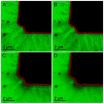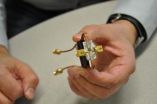(Press-News.org) DOWNERS GROVE, Ill. – February 19, 2014 – New research shows that the addition of confocal laser endomicroscopy to high-definition white-light endoscopy enables improved real-time endoscopic diagnosis of Barrett's esophagus dysplasia (neoplastic tissue) by using targeted biopsies of abnormal mucosa to reduce unnecessary mucosal biopsies and potentially reduce costs. It may also positively influence patient care by changing the plan for immediate endoscopic management. The study appears in the February issue of GIE: Gastrointestinal Endoscopy, the monthly peer-reviewed scientific journal of the American Society for Gastrointestinal Endoscopy (ASGE).
Barrett's esophagus (BE) is a precancerous change in the epithelial lining of the esophagus that is associated with the development of esophageal cancer. The current best, though imperfect, marker of neoplastic progression is dysplasia (abnormality in cells which have undergone early changes on a path toward possible malignancy) detected in mucosal biopsy specimens of the lining of the esophagus obtained at the time of endoscopy. High-grade dysplasia is associated with a high rate of progression to invasive esophageal cancer. Detection and pathologic confirmation of early BE neoplasia (high-grade dysplasia or early esophageal cancer) is important because endoscopic therapy at this point is highly successful. Unfortunately, neoplasia in BE may not be evident even with only endoscopic inspection, so the current standard of care is endoscopic surveillance with high-quality white-light endoscopy using systematic 4-quadrant biopsies every 1 to 2 cm of BE length and targeted biopsies of any mucosal irregularities. A large number of biopsies may be required using this random biopsy method, resulting in high cost and increased time. This method has a low (1 percent to 10 percent) diagnostic yield for neoplasia and may result in lower adherence to practice guidelines.
Confocal laser endomicroscopy (CLE) is a relatively new endoscopic imaging technique that combines endoscopy and microscopic imaging of the gastrointestinal (GI) mucosa (the superficial lining of the GI tract). A previous single-center, randomized, crossover study, demonstrated a greater diagnostic yield for the detection of BE neoplasia with an in vivo fluorescein-aided endoscope-based CLE system (eCLE).
"Our study compared the diagnostic yield and accuracy of high definition white-light endoscopy (HDWLE) and random biopsy with that of HDWLE plus real-time eCLE imaging and targeted tissue sampling of BE, and determined the impact of in vivo eCLE on real-time clinical decision making in patients with BE," said study lead author Marcia Irene Canto, MD, MHS, FASGE, Johns Hopkins University, Baltimore, Maryland. "We found that real-time eCLE and targeted biopsy after HDWLE can improve the diagnostic yield and accuracy for neoplasia and significantly impact in vivo decision making by altering the diagnosis and guiding therapy."
Methods
This was a multicenter, randomized, controlled trial of 192 adult patients with BE undergoing routine surveillance or referred for early neoplasia from February 2010 to December 2012 at academic medical centers. The researchers' objective was to compare high-definition white-light endoscopy (HDWLE) alone with random biopsy (RB) and HDWLE plus eCLE and targeted biopsy (TB) for diagnosis of BE neoplasia. Patients were randomized to HDWLE plus RB (group 1) or HDWLE with eCLE and TB (group 2). Real-time diagnoses and management plans were recorded after HDWLE in both groups and after eCLE in group 2. Blinded expert pathology diagnosis was the reference standard. The main outcomes were diagnostic yield, performance characteristics, and clinical impact.
Results
HDWLE plus eCLE and TB (group 2) led to a lower number of mucosal biopsies and higher diagnostic yield for neoplasia (34 percent vs 7 percent), compared with HDWLE and RB (group 1) but with comparable accuracy. HDWLE plus eCLE and TB tripled the diagnostic yield for neoplasia (22 percent vs 6 percent) and would have obviated the need for any biopsy in 65 percent of patients. The addition of eCLE to HDWLE increased the sensitivity for neoplasia detection to 96 percent from 40 percent without significant reduction in specificity. In vivo CLE changed the treatment plan in 36 percent of patients. An eCLE was performed successfully and safely in all patients. There were no adverse reactions to fluorescein administration.
The researchers noted several limitations including that the study was only at academic centers with highly experienced endoscopists. The results may not be generalizable to community-based physicians, less-experienced practitioners and nonacademic practices. Second, they used the eCLE system, and their findings may not be generalizable to other pCLE systems. Also, the endoscopists were not blinded to prior endoscopy and pathology results because these were necessary for standard medical care and in vivo decision making regarding biopsy or EMR.
The researchers concluded that the addition of in vivo imaging with eCLE to HDWLE is associated with improved targeting of neoplasia, a decrease in unnecessary mucosal biopsies and a significant change in diagnosis and management plans in patients with BE. The approach of real-time CLE diagnosis and imaging-guided therapy represents a potential paradigm shift in BE surveillance. Research studies are needed to address training in CLE, comparative effectiveness studies of advanced endoscopic imaging techniques, the role of imaging-guided therapy and advances in CLE devices and contrast agents.
In an accompanying editorial, Manuel Berzosa, MD and Michael B. Wallace, MD, MPH, Mayo Clinic, Jacksonville, Florida, stated, "This is an important study for Barrett's esophagus surveillance because it demonstrates that a targeted biopsy strategy using endoscope based confocal laser endomicroscopy can be a superior alternative to random biopsy protocols."
INFORMATION:
About the American Society for Gastrointestinal Endoscopy
Since its founding in 1941, the American Society for Gastrointestinal Endoscopy (ASGE) has been dedicated to advancing patient care and digestive health by promoting excellence and innovation in gastrointestinal endoscopy. ASGE, with more than 12,000 members worldwide, promotes the highest standards for endoscopic training and practice, fosters endoscopic research, recognizes distinguished contributions to endoscopy, and is the foremost resource for endoscopic education. Visit http://www.asge.org and http://www.screen4coloncancer.org for more information and to find a qualified doctor in your area.
About Endoscopy
Endoscopy is performed by specially-trained physicians called endoscopists using the most current technology to diagnose and treat diseases of the gastrointestinal tract. Using flexible, thin tubes called endoscopes, endoscopists are able to access the human digestive tract without incisions via natural orifices. Endoscopes are designed with high-intensity lighting and fitted with precision devices that allow viewing and treatment of the gastrointestinal system.
Study shows in vivo endomicroscopy improves detection of Barrett's esophagus-related neoplasia
2014-02-19
ELSE PRESS RELEASES FROM THIS DATE:
RXTE reveals the cloudy cores of active galaxies
2014-02-19
VIDEO:
Zoom into the cloudy heart of an active galaxy. This animation shows an artist's rendition of the cloudy structure revealed by a study of data from NASA's Rossi X-Ray Timing...
Click here for more information.
Picture a single cloud large enough to span the solar system from the sun to beyond Pluto's orbit. Now imagine many such clouds orbiting in a vast ring at the heart of a distant galaxy, occasionally dimming the X-ray light produced by the galaxy's monster black ...
NuSTAR helps untangle how stars explode
2014-02-19
For the first time, an international team of astrophysicists, including Lawrence Livermore National Laboratory scientists, have unraveled how stars blow up in supernova explosions.
Using NASA's Nuclear Spectroscopic Telescope Array (NuSTAR) – a high-energy X-ray observatory - the international collaboration created the first-ever map of radioactive material in a supernova remnant, named Cassiopeia A, or Cas A for short. The findings reveal how shock waves likely rip apart massive dying stars, and ultimately end their lives.
A supernova is the cataclysmic death of a ...
REACT clinical trial supports new approach of accelerated treatment for Crohn's disease
2014-02-19
The final results from an international clinical trial involving nearly 2,000 patients with Crohn's disease support the use of a new management strategy referred to as accelerated step-care as a best practice for the care of active Crohn's disease. The REACT (Randomized Evaluation of an Algorithm for Crohn's Treatment) study, led by Robarts Clinical Trials at Western University (London, Canada) provides valuable new insights for community gastroenterologists which should benefit patients. The results of the study will be presented at the European Crohn's and Colitis Organisation ...
ORNL microscopy system delivers real-time view of battery electrochemistry
2014-02-19
OAK RIDGE, Tenn., Feb. 19, 2014 -- Using a new microscopy method, researchers at the Department of Energy's Oak Ridge National Laboratory can image and measure electrochemical processes in batteries in real time and at nanoscale resolution.
Scientists at ORNL used a miniature electrochemical liquid cell that is placed in a transmission electron microscope to study an enigmatic phenomenon in lithium-ion batteries called the solid electrolyte interphase, or SEI, as described in a study published in Chemical Communications.
The SEI is a nanometer-scale film that forms ...
Many Texans struggling to pay for health service as Affordable Care Act is about to launch
2014-02-19
HOUSTON – (Feb. 19, 2014) – Many Texans were struggling to pay for basic health services on the eve of the launch of the Affordable Care Act's Health Insurance Marketplace, according to a report released today by Rice University's Baker Institute for Public Policy and the Episcopal Health Foundation. The report also found that even those with health insurance reported dissatisfaction with the cost and availability of services. Most Texans expect more of the same in 2014.
The Health Reform Monitoring Survey (HRMS)-Texas report is based on the HRMS, a national project that ...
Molecular aberration signals cancer
2014-02-19
Several scientists, including one at Simon Fraser University, have made a discovery that strongly links a little understood molecule, which is similar to DNA, to cancer and cancer survival.
EMBO Reports, a life sciences journal published by the European Molecular Biology Organization, has just published online the scientists' findings about small non-coding RNAs.
While RNA is known to be key to our cells' successful creation of proteins, the role of small non-coding RNAs, a newly discovered cousin of the former, has eluded scientific understanding for the most part. ...
Cell therapy shows remarkable ability to eradicate cancer in clinical study
2014-02-19
NEW YORK, February 19, 2014 — Investigators from Memorial Sloan Kettering Cancer Center have reported more encouraging news about one of the most exciting methods of cancer treatment today. The largest clinical study ever conducted to date of patients with advanced leukemia found that 88 percent achieved complete remissions after being treated with genetically modified versions of their own immune cells. The results were published today in Science Translational Medicine.
"These extraordinary results demonstrate that cell therapy is a powerful treatment for patients who ...
LGBT youth face greater cancer risks, CCNY-led study
2014-02-19
A new study led by City College of New York psychologist Margaret Rosario found that youths of same-sex orientation are more likely to engage in behaviors associated with cancer risk than heterosexuals. The peer-reviewed findings appear in the February 2014 issue of the American Journal of Public Health.
Titled "Sexual Orientation Disparities in Cancer-Related Risk Behaviors of Tobacco, Alcohol, Sexual Behaviors, and Diet and Physical Activity: Pooled Youth Risk Behavior Surveys," the study pooled YRBS (Youth Risk Behavior Survey) data from 2005 and 2007. The YRBS is ...
Using holograms to improve electronic devices
2014-02-19
RIVERSIDE, Calif. (http://www.ucr.edu) — A team of researchers from the University of California, Riverside Bourns College of Engineering and Russian Academy of Science have demonstrated a new type of holographic memory device that could provide unprecedented data storage capacity and data processing capabilities in electronic devices.
The new type of memory device uses spin waves – a collective oscillation of spins in magnetic materials – instead of the optical beams. Spin waves are advantageous because spin wave devices are compatible with the conventional electronic ...
Statistics research could build consensus around climate predictions
2014-02-19
Philadelphia, PA—Vast amounts of data related to climate change are being compiled by research groups all over the world. Data from these many and various sources results in different climate projections; hence, the need arises to combine information across data sets to arrive at a consensus regarding future climate estimates.
In a paper published last December in the SIAM Journal on Uncertainty Quantification, authors Matthew Heaton, Tamara Greasby, and Stephan Sain propose a statistical hierarchical Bayesian model that consolidates climate change information ...




